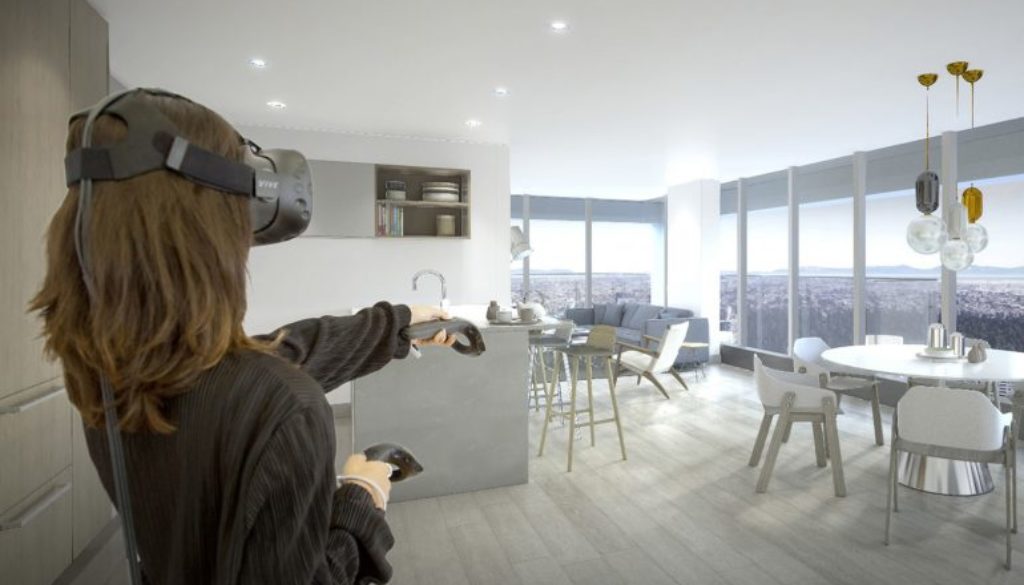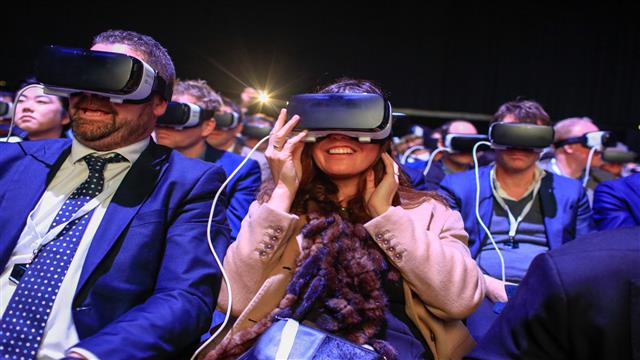Virtual Reality (VR) creates a computer-generated world with realistic scenes and objects, giving a sense of immersion to the user. Virtual Reality is experienced through the use of a headset or helmet. In VR, we can learn how to perform heart surgery, play video games like characters, improve sports training to achieve maximum performance.
Despite its futuristic appearance, this technology is not nearly as recent as we might think. The first Virtual Reality device was called Sensorama, a machine with a built-in seat that played 3D movies, emitted odors, and generated vibrations to make the experience as realistic as possible. Invented in the 1950s, it was first used in the 1960s. Following the development of technology and software over the following years, the design of devices and interfaces evolved gradually.

Through science fiction and especially Star Trek: The Next Generation, virtual reality gained prominence as an interactive environment that can be used for education, entertainment, and fun. This environment was often a source of mishaps, but the virtual reality we have access to today and that will become available in the future is not like that.
From 2020 to 2027 the compound annual growth rate of the virtual reality market is 21.6%
Present VR Usage in Different Sectors:
Immersing VR technology into every sector is becoming more and more common. Research was conducted by Finances Online on which industries use VR the most. This technology will revolutionize the way we entertain, treat, travel, learn, communicate, purchase items, and work in the future.
At present the scope of Virtual Reality is the highest in the Gaming sector
- VR users in the US number 57.4 million (eMarketer, 2020)
- The industry is expected to invest $915 million by 2020 (Superdata).
- VR or AR technology is already being embraced by 91% of businesses (TechRepublic, 2020).
1. VR in education and training

In education and training, the goal of virtual reality is to make the technology as engaging as possible and to change the way people learn. Many startups and established education companies have begun offering packaged services and experiences geared toward schools.
Currently, virtual education is popular with K-12 students, higher education, and vocational training and it is anticipated that virtual reality will make virtual education even more common. In higher education, where VR applications are expected to become more important, there are applications for recruitment, immersion learning, and fundraising.
The Harward business school study found that medical students trained with virtual reality were more skillful and faster at performing certain types of procedures than their peers trained with traditional methods.
Simulating heavy urban traffic with virtual reality applications, for instance, helps people prepare for safe driving on real roads by providing experience and knowledge of the situation. NIX engineers also have a personal accomplishment, namely a driving simulator that provides an immersive driving experience.
2. VR in Real Estate

The possibilities of showing virtual real estate have increased significantly in this pandemic era. You can observe your property in its current state as well as how it will appear in the future once built by wearing a virtual reality headset. Regardless of the location of the property, you can schedule a tour from the comfort of your apartment. How easier could it be to wander around your apartment while wearing a VR headset?
The client gets a unique chance to tour the area, allowing them to decide whether it’s comfortable and spacious enough to invest in. When there is a level of emotional connection between a client and a realtor, it is far easier for them to turn that client into a buyer. In this way, customers in their living rooms can experience how their future home, which might be 1,000 kilometers away, looks like with 360-degree video. Prototyping allows clients to visualize what their apartment or house will look like in the future rather than seeing bare walls as they do now.
Making a positive decision and investing in a home can be influenced by a virtual room tour.
3. VR in Manufacturing

In manufacturing, virtual technologies provide significant improvements in terms of cost, time, and quality. Engineers and designers have the opportunity to explore options that would have been prohibitively expensive or time-consuming in the past.
Virtual reality specialists have been hired by Ford to lead engineers in developing entire cars in a virtual environment, including autonomous cars. Ford currently requires all vehicles going into production to undergo a multi-functional VR review.
Using virtual reality technology, you can conduct machine training. Optimal operation of a machine is primarily determined by the skill and knowledge of its operators. You cannot begin working as an operator until you pass an exam and obtain a license; however, a license doesn’t always indicate how skilled you are. Companies can provide their employees with an easy, relatively inexpensive, and relatively safe way to be trained thanks to new technology, in an environment where every type of error can be very costly.
4. VR in Healthcare

A similar rule goes for medicine, and especially for emergency medicine. Using a VR simulation, medical professionals can learn how to perform every procedure, from CPR to lumbar puncture, after they are put into a lifelike VR scenario. Furthermore, the training can be supplemented with a program that evaluates the trainee’s performance, marks any mistakes, and offers recommendations to avoid them in the future.
In addition to medical training, virtual reality technology is used in many other areas. The use of VR in healthcare includes the treatment of mental illness as well as disease awareness.
VR offers an excellent method for physical and psychological treatment and pain management by enabling a person to be inserted into any environment via controlled simulation. A number of clinicians already use VR to treat patients with PTSD, anxiety, or phobias. Rehabilitation can be a part of VR for stroke survivors, brain injured patients, and others. In this case, gamification plays a role, which allows the patient to remain focused and places them in a familiar environment with activities they are familiar with, such as driving, cooking, or other activities, allowing them to quickly regain motor function.
5. VR in Gaming

Certainly, the average person associates virtual reality with gaming as the first thing that comes to mind when they hear the term. VR gaming market size is growing rapidly, and that’s not surprising.
COVID-19, meanwhile, influences VR technology’s current position in gaming because it keeps potential customers at home, and consequently, they are more inclined to play online games, which will benefit the market.
There have been times when the ideas realized in the gaming sector with virtual reality are a lot more captivating than those in other fields because they offer more fantasy and progress. Probably for this reason, experts are seeing potential for VR in the gaming sector.
Future of Virtual Reality by 2025
Capgemini Research Institute’s 2018 report states that “82 % of companies currently using AR or VR solutions are either meeting or exceeding expectations.”
Let’s explore what VR technology has to offer in the future!
Trend #1: Artificial Intelligence Enhanced Virtual Reality

In the future, virtual reality will merge with artificial intelligence, and the truth is, it has become inevitable. Business stakeholders have already experienced the benefits of this fusion in a variety of ways, including improved productivity and streamlined workflows, but researchers and developers are pursuing several other potential benefits.
Firstly, it is important to mention that optimization of development tools can help create, generate, and calculate elements faster, as well as optimization of the process that enables VR to run on less demanding hardware. Furthermore, AI can automatically generate different objects for VR applications, making the development process cheaper and less time-consuming.1 Experts predict that this will eventually lead to the development of highly interactive workspaces and advanced image recognition tools.
Trend #2: Virtual Reality for Online Conferences and Sport Spectaculars

Technology can be used to help create more immersive events and sporting matches as a growing trend in virtual reality and augmented reality. Because of the COVID-19 pandemic, online conferences and sporting events have been postponed, but the use of these technologies to promote sports and events is already taking priority. Major sports companies and events are investing in virtual and augmented reality technologies.
Thanks to technology, sports fans can watch their favorite teams, even if they are physically on the other side of the world. Specifically, the meetings and events will be virtual but immersive, and go beyond the regular videoconferences. There are numerous examples of such teams in the NFL, such as the Dallas Cowboys, New England Patriots, and San Francisco 49ers.
In the years to come, virtual reality technology will allow fans to immerse themselves in gaming and will also engage employees and partners in meetings and events. In addition, the best seats are always yours.
Trend #3: Remote learning and education becoming more common

As an example, Teslasuit’s full-body suit provides extensive, immersive haptic feedback, which enhances the feeling of immersion. Additionally, it features a variety of biometric sensors for measuring heartbeats, sweat, and other stress indicators. Performance monitoring and sensations are elements of this suit that simulate experience and accelerate VR training.
NASA uses Teslasuits in their astronaut training, but it is a powerful XR training tool with endless potential. At the moment, such equipment is expensive, but as the technology evolves, it will become increasingly more affordable.
COVID-19 is making virtual reality technology an increasingly important part of education and training in distance learning systems. A number of companies, including Facebook, HTC, and the European Commission, rely on Engage for their online learning initiatives.
Trend #4: Entertainment powered by VR

Several non-gaming applications of VR technology have already been discussed, but analysts predict gaming will be a significant driver of revenue growth for VR. By 2026 or 2027, it is expected that global gaming revenue will reach nearly $50 billion. In turn, game developers continue to create more and more constantly evolving entertainment technology to satisfy gamers and attract them to buy new products.
Technology such as virtual reality offers a whole new world of entertainment that will enable the entertainment industry to reach a broader audience and grow. Simply putting on a headset that broadcasts live lets you watch concerts by world stars, Oscar-nominated movies, or talk shows hosted by Jimmy Fallon in real time. Virtual reality experiences have also been used in television shows like Game of Thrones.
Virtual reality entertainment is also found in Google Expeditions. Explorations of history, science, and art are included in these expeditions. Technology allows you to build up a wide range of subjects, ranging from dinosaurs in their natural habitats to Renaissance art details.
Trend #5: VR in Advertising and Marketing

With virtual reality technology becoming more mainstream and its integration into everyday life, businesses will have more opportunities to advertise. In an era where consumers spend increasingly more time on their smartphones and computers, and this technology is increasingly used, businesses have a better chance to reach potential customers on their way to VR technology’s future, and can target their advertising to the right niche and the right clientele.
Your audience will experience a completely unique experience with the use of virtual reality. Through seamless and interactive content integration (e.g. product placement), you can measure the response of viewers to your product and take better data-driven decisions to improve your product.
As part of its “The Migraine Experience” campaign, GlaxoSmithKline (GSK) integrated virtual reality technology into the campaign. People suffering from migraines chose symptoms, and then handed the headset to partners without migraines who could experience both the physical pain and the symptoms in VR. In addition, GSK released an app that anyone can download from their smartphones and use.
Wouldn’t this be an awesome insight into the future of marketing and advertising with VR technology?
Conclusion
Businesses and customers alike can benefit from participating in this technology. In the future, VR will offer even more opportunities for those who want to experience technological innovation at its best. You will need a team of tech specialists who can support you on this path if you want to stay current with the times and grow your business. At NIX, we believe virtual reality opens an almost limitless number of possibilities. The virtual reality technology we use is changing the way the world does things forever and we have vast experience in adapting solutions to the latest trends.





